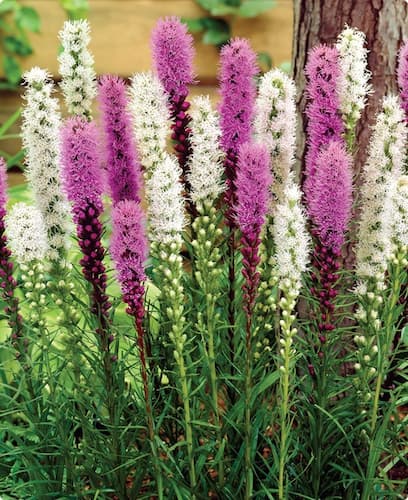How to Grow and Care for Blazing Star Flowers

About Growing Blazing Star Plants in Your Home Flower Garden
Whether you know this flowering plant as Liatris or Blazing Star flowers, you’ll enjoy its’ attractive and stately appearance. And, growing Blazing Star perennial plants is easy. Liatris is native to America east of the Rocky Mountains. The Liatris plant grows one to five feet tall, depending upon which of a couple of dozen varieties you have, and the growing conditions. It produces tall spikes with bright purple flowers. Unlike most other spiked flowers, Liatris flowers bloom beginning from the top, progressing down the spike. The leaves are green and finely textured, turning a showy bronze in the Fall.
Liatris is good for cut flowers, fresh or dried. Florists consider it a good flower for weddings.
Other Names: This flowering plant is also known as Gayfeather, Colic Root, and Button Snake Root
Flowers Bloom: Summer to early Fall.
Flower Colors: Purple, reddish-purple, and white.
Plant height: One to six feet tall, depending upon variety.
Plant Hardiness Zones: 9 – 11
Perennial, Tacca Chantrieri
Medicinal Uses
Liatris was used as an old-fashioned antispasmodic remedy for the intestines. It is used for backaches and limb pains. It also is used to treat sore throats and kidney disease.
Blazing Star Flower Plant Propagation
Liatris, or Blazing Star, are grown from Corms or Rhizomes (depending upon the variety). The plants spread, filling in empty spaces over time. After a few years, the clumps need to be dug up, and separated.
Liatris can also be grown from seeds. If grown from seeds, they will bloom the second year after planting them.
Seeds have a long germination period: 20-45 days.
Rhizome Planting Depth: Plant rhizomes (or corms) 2 to 3 inches deep.
Final Plant Spacing: 4 to 8 inches apart.
How to Grow Blazing Star Flowers
Growing Blazing Star plants is easy. They prefer full sun but will tolerate partial, light shade. Select a planting site that gets no less than 6 hours of full sunlight. The flowers begin to bloom in the second year after planting them. You need patience when growing these flowers. It can take up to two years for a new plant to fully bloom.
Liatris plants like rich, moist soil that is well-draining. However, they will tolerate varying soil conditions and fertility. It is most important that the soil is not wet or soggy for extended periods, as the roots will rot.
Water plants only if the soil is dry down a few inches. Add a layer of mulch to keep the weeds down, and your Liatris will grow almost maintenance-free.
Add a general-purpose fertilizer after the blooming period.
You will know when it is time to divide the plants, as the plants and flowers will grow smaller than normal. Divide and separate…… After a few years, the clumps of flowers need to be separated. Dig them up. Separate the Rhizomes, using a sharp knife. Make sure at least one “eye” is on each segment. Replant the rhizomes
Ideal Soil pH: 5.5 – 7.5
Insects and Plant Disease
You should experience a few insect problems with your Liatris. Occasionally, leaf spot disease and powdery mildew can pose a problem.
As previously mentioned, the roots will rot in soggy, wet soils, Avoid planting them in low areas, with poor drainage.
Related Articles
Also, people who read this article will like:
Flower Gallery Find pictures of your favorite flowers.
Buy Bulbs and Plants – Enjoy this unique bloomer.
Please support our site. Shop for:
- rmmatthews100@hotmail.com
- 585-721-6528
- Rochester, NY
©1999-2024 GardenersNet.Com, All Rights Reserved

